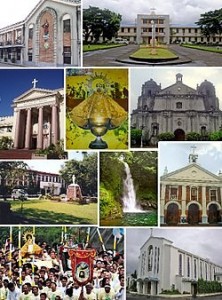Naga
Geographical Address

Naga, officially the City of Naga (Central Bikol: Ciudad nin Naga; Rinconada Bikol: Syudad ka Naga; Filipino: Lungsod ng Naga; Spanish: Ciudad de Naga), or known simply as Naga City, is a 2nd class independent component city in the Bicol Region, Philippines. According to the 2015 census, it has a population of 196,003 people.[9] Majority of Naga's population are 15 years and below.
The town was established in 1575 on order of Spanish Governor-General Francisco de Sande, the city, then named Ciudad de Nueva Cáceres (New Cáceres City), earned its status as the third Spanish Royal City in the Spanish East Indies after Iloilo and Manila.
Geographically and statistically classified under Camarines Sur but administratively independent, Naga is the Bicol Region's trade,[12][13] business,[13] religious, cultural, industrial, commercial,[14] medical,[15][16] educational[14] and[17] financial center.[18][19][20][21][22][23][24][25] It was awarded as the "Most Competitive Component City in the Philippines"[26][27] also being "the Center of Good Governance in the Philippines".[28]
Naga is known as the "Queen City of Bicol",[29][30] and as the Heart of Bicol[31][32] due to its central location in the Bicol Peninsula; and as the Pilgrim City because Naga is also home to the largest Marian pilgrimage in Asia, the Our Lady of Peñafrancia. Naga is also known as One of the Seven Golden Cities of the Sun as stated by Nick Joaquin.[33][34]
The city is the seat of the Metropolitan Roman Catholic Archdiocese of Caceres, which makes the city Bicol's religious center, whose jurisdiction includes all the suffragan sees of Bicol, the Dioceses of Daet, Legazpi, Libmanan, Masbate, Sorsogon, and Virac.[35]
Moreover, the city is also the seat of the widely venerated Our Lady of Peñafrancia, the Patroness of Bicol. The image is one of the most popular objects of devotion in the country.[35] The other important catholic symbol which is venerated in the region is the Santo Rostro, Veil of Veronica, introduced around 1880 in the region by Pedro de la Torre del Pozo, a priest from Osa de la Vega, Spain.
Naga is the core of Metro Naga, an official designation given the city and 14 municipalities in the area administered by the Metro Naga Development Council.
When someone speaks about Naga, it immediately refers to the Bicolandia, and this has always been, since from the time Naga became a full-fledged city. However, this connotation has changed since 2007, when another Naga, became a city, which is located in Cebu. This confusion is prevalent among Cebuanos, Boholanos and people coming from other Visayan-Speaking areas that had lived or visited Cebu, as they would always mistaken Naga as the city located in Cebu, and not in Bicolandia, although modern media and information in the internet had lessened this occurrences.
https://en.wikipedia.org/wiki/Naga,_Camarines_Sur
Map
-
{{#owner}}
-
{{#url}}
{{#avatarSrc}}
{{name}} {{/url}} {{^url}} {{#avatar}} {{& avatar}} {{/avatar}} {{name}} {{/url}} - {{/owner}} {{#created}}
- {{created}} {{/created}}


